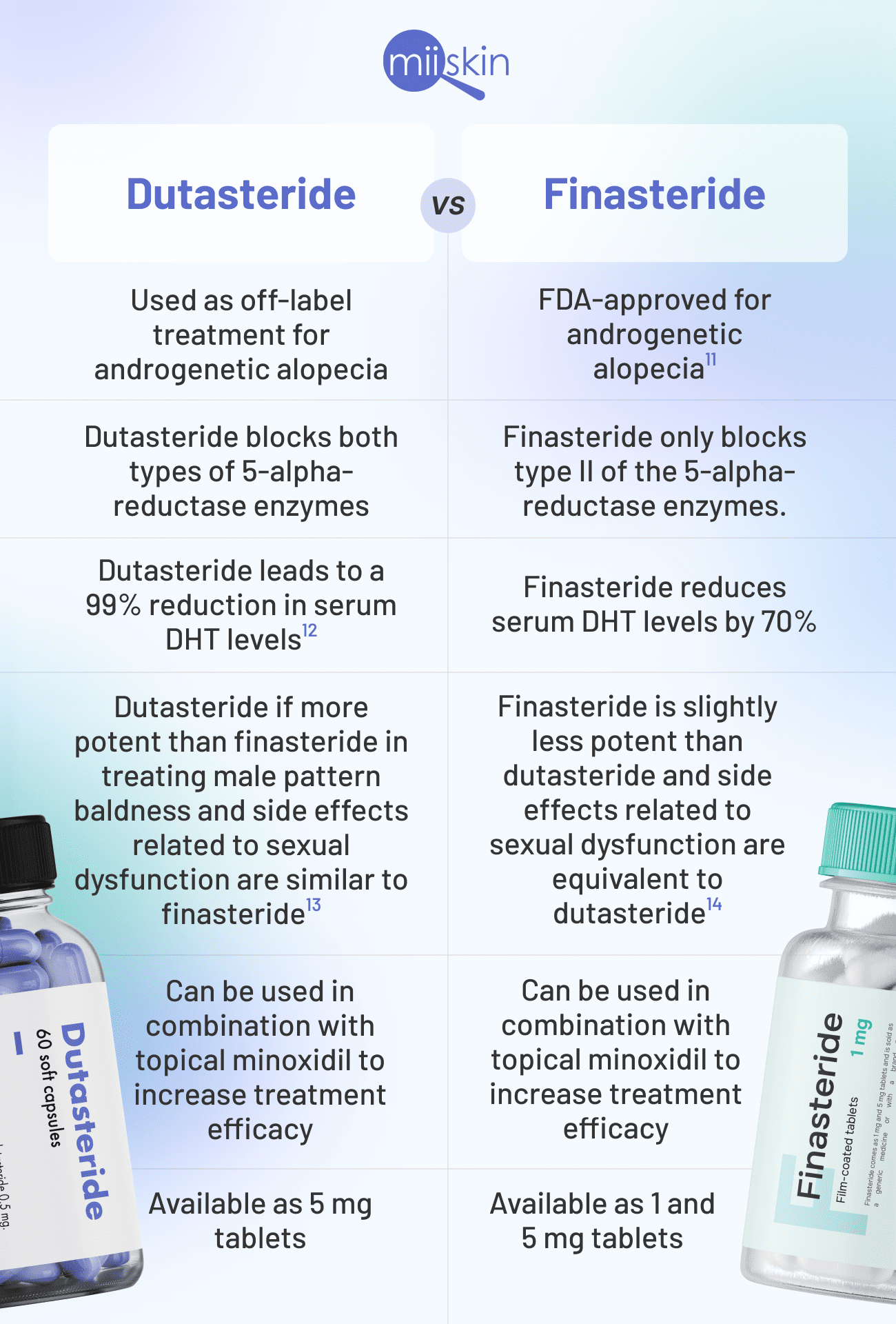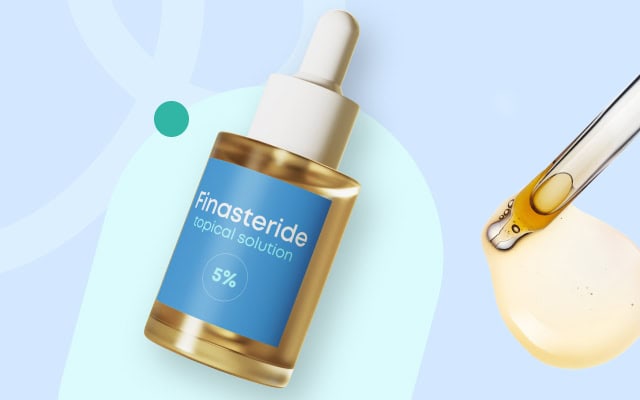Dutasteride vs finasteride for male androgenetic alopecia: A full comparison
Dutasteride and finasteride are very similar drugs used to reduce hair loss and stimulate hair growth, but what are their differences? Keep reading to find out!
Table of Content:
Male androgenetic alopecia | Similarities | Differences | Side effects | Warnings | Finasteride | Dutasteride | FAQ
Our commitment to producing high-quality content:
The information presented in this article is based on scientific research and the professional advice of our Content Medical Reviewers, who are experts in the field of Dermatology. How we write our content →
In this article, we will explore the similarities and differences between dutasteride and finasteride, two commonly prescribed medications used for hair loss in men. We will also dive into the effectiveness of each drug in treating this condition, as well as their potential side effects and drawbacks.
Understanding the similarities and differences between these and other medications (such as minoxidil) for androgenic alopecia can help you and your online dermatologist to make informed decisions about your treatment options.
How does finasteride and dutasteride help with hair loss?
Dr. Anna Chacon, board-certified dermatologist, says that finasteride and dutasteride are DHT blockers, which means they block the conversion of testosterone into DHT which causes hair follicles to miniaturize, leading to hair loss. By reducing DHT levels in the body, finasteride and dutasteride help to slow or even reverse the process of follicular miniaturization6 7 .
How to get a prescription for finasteride and dutasteride?
Consult a hair loss dermatologist online and request a prescription with a photo-based consultation . Photo consultations start at $59, and you will get a response in less than 2 days.
Similarities between finasteride and dutasteride
According to Dr. Chacon the main similarity between finasteride and dutasteride is that they are both prescription medications used to treat male androgenetic alopecia and they work similarly by reducing the levels of DHT in the body which regulates abnormal prostate growth, reduces hair loss, and stimulates hair growth8 9 .
Both products have similar prices and are covered by most commercial insurance health plans, besides they can both be used in combination with topical minoxidil to maximize hair growth.
Finasteride vs dutasteride: what are the differences?
The main difference between these two drugs according to Dr. Chacon is that while they work in similar ways, dutasteride is slightly more potent since it blocks more of the conversion of testosterone to dihydrotestosterone (DHT)10.
Another important difference is that for some reason, only finasteride is FDA- approved for the treatment of androgenetic alopecia while dutasteride is used as an off-label treatment.

Finasteride: brand names, price and formulations
Finasteride comes as 1 mg and 5 mg tablets and is sold as a generic medicine or with a brand name.
The price of finasteride is approximately $15 to $35 depending on the dose, pharmacy and coupons available and many commercial health insurances cover it.
- Proscar is a brand name for finasteride which comes as a 5 mg tablet
- Propecia is a brand name for finasteride which comes as a 1 mg tablet
*The price range listed here is just an estimation. Medication prices may vary depending on the state and the pharmacy selected. Miiskin is not responsible and cannot influence the price of the medication as it is independent from these entities.
Dutasteride: brand names, price and formulations
Dutasteride comes as 0.5 mg tablets and is sold as a generic medication or with the brand name of Avodart.
The price of dutasteride is similar to finasteride, approximately $15 to $30 depending on the pharmacy and coupons available and many commercial health insurances cover it*.
*The price range listed here is just an estimation. Medication prices may vary depending on the state and the pharmacy selected. Miiskin is not responsible and cannot influence the price of the medication as it is independent from these entities.
Side effects of dutasteride and finasteride
Common side effects of finasteride and dutasteride
Finasteride and dutasteride may cause similar side effects.
- Decreased libido
- Erectile dysfunction
- Decreased semen volume
- Gynecomastia (enlarged breasts)
However, once treatment is stopped, these side effects will disappear and hair loss may continue15 16.
Uncommon side effects of finasteride and dutasteride
- Lumps, swelling or pain in your chest area
- Discharge from your nipples
- Depression17
Warning and precautions of finasteride and dutasteride
Finasteride and dutasteride pills should be swallowed as whole tablets and not crushed or chewed. They should also be taken at the same time each day.
It is very important that your online dermatologist checks your progress to ensure the medicine works, and if you should continue taking it. Your doctor may recommend you have some blood and urine tests to check for unwanted effects.
Women and children should not use this medicine. Women who are pregnant or may become pregnant should not handle these tablets as these ingredients may be absorbed through the skin and may cause birth defects in babies. If a woman comes in contact with this medicine, wash the affected area right away with soap and water18 19 .
FAQ
Is there a topical version of finasteride?
Yes, sometimes dermatologists may compound topical finasteride + minoxidil if they believe it is adequate for you. If your dermatologists prescribes this customized formula for your hair, you can buy it via an online compounding pharmacy.
Is there a topical version of dutasteride?
Yes, there is also a topical version of dutasteride + minoxidil that you can request with a photo-consultation and will be prescribed to you via an online compounding pharmacy.
What is the price of finasteride and dutasteride?
The price oral finasteride varies between $12 – $40 for 30 generic tablets. Branded medication is usually more expensive. Oral dutasteride has a similar price*.
*The price range listed here is just an estimation. Medication prices may vary depending on the state and the pharmacy selected. Miiskin is not responsible and cannot influence the price of the medication as it is independent from these entities.
Who can take finasteride and dutasteride ?
Men with male pattern baldness who have a medical prescription from a healthcare provider, can safely use both medications, finasteride and dutasteride.
Who should not take finasteride and dutasteride?
Women and children should not take finasteride or dutasteride, especially pregnant and nursing women because these medications may cause harm to the baby.
How long does it take to see results from dutasteride or finasteride?
It may take up to a year or more for dutasteride to fully take action in terms of both reducing hair loss and promoting hair growth. However, some men may see improvement in hair growth as early as 3 months into treatment20.
After three to four months of usage, many men who take finasteride see slight improvements; nevertheless, “final” outcomes from finasteride therapy often take about a year to manifest21.
To learn more about other forms of hair loss, check out our post on ‘What are the different types of alopecia?‘ Board-certified dermatologist Eric Howell discusses the many forms of alopecia and outlines available treatments.
Key article points
- Purpose of Finasteride and Dutasteride: Both finasteride and dutasteride are oral medications used to treat male androgenetic alopecia (male pattern baldness) by reducing DHT levels, helping to slow or reverse hair loss.
- Potency and FDA Approval: Dutasteride is more potent than finasteride, blocking more of the DHT conversion, but only finasteride is FDA-approved for treating male pattern baldness, while dutasteride is used off-label.
- Side Effects: Both medications can cause similar side effects, including decreased libido, erectile dysfunction, and gynecomastia, which typically resolve after discontinuing the medication.
- Usage and Combination with Minoxidil: Both drugs can be combined with topical minoxidil to enhance hair growth effectiveness, and they require a prescription to be purchased.
- Time to See Results: It can take three to twelve months to see significant results from either medication, with dutasteride generally being more potent and potentially faster-acting than finasteride.
Do you need a hair loss prescription?
Article References:
https://www.ncbi.nlm.nih.gov/books/NBK278957/ https://www.ncbi.nlm.nih.gov/pmc/articles/PMC3853891/
https://onlinelibrary.wiley.com/doi/full/10.1111/exd.13029
https://www.ncbi.nlm.nih.gov/books/NBK513329/
https://pubmed.ncbi.nlm.nih.gov/28294070/
https://www.ncbi.nlm.nih.gov/pmc/articles/PMC6388756/
https://www.ncbi.nlm.nih.gov/books/NBK513329/
https://www.sciencedirect.com/science/article/pii/S0022202X15529357
https://www.nhs.uk/medicines/finasteride/
https://www.mayoclinic.org/drugs./finasteride./drg-20063819?p=1
https://www.mayoclinic.org/drugs-supplements/dutasteride-oral-route/precautions/drg-20063575
https://medlineplus.gov/druginfo/meds/a603001.html
https://www.jaad.org/article/S0190-9622(98)70007-6/fulltext
Hair loss articles
Reviewed by dermatologists
Using oral minoxidil at a low dose for hair loss
How to stop alopecia areata from “spreading”?
Does creatine cause hair loss?
Can I use a derma roller with minoxidil for enhanced hair growth?






 Interested in getting a prescription for finasteride or dutasteride?
Interested in getting a prescription for finasteride or dutasteride?